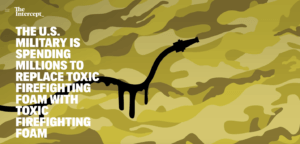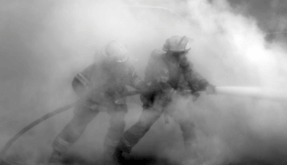February 2018: Is That Jacket Making You Fat?
In this edition:
- Environmental Injustice: The Contamination of the Arctic
- Oil Fumes With Toxic Flame Retardants on Board
- Flame Retardants Can Increase Toxic Smoke More Than They Reduce Fires
- BPA: A High Price to Pay for a Receipt

Big news on the chemical class concept!
Last Thursday the California Department of ToxicSubstances Control (DTSC) announced a proposal to list carpets and rugs containing any member of the class of highly fluorinated chemicals (PFAS) as Priority Products under their Safer Consumer Products Regulations. You can register here for their March 20 workshop (in person or via webcast) or comment here until March 23, 2018. And Washington State also has legislation moving forward to ban the use of the entire class of PFAS in food contact materials and fire-fighting foam. Stay tuned!
And in case you missed it, check out our three-minute long video on the Consumer Product Safety Commission (CPSC) Landmark Decision on Toxics. View eloquent testimony contributing to the CPSC decision to ban furniture, electronics cases, mattresses and children’s products containing organohalogen flame retardants. The Earth Justice Magazine tells the story of Eve Gartner and our Institute’s successful science-based petition: How Two Women Teamed Up to Take on the Chemical Industry and Won.
Eve Gartner was one of the excellent speakers at our February 9, 2018 Flame Retardant and Beyond Symposium at UC Berkeley where 100 participants from a variety of fields enjoyed a day of discussions about reducing harm from toxics. Thanks to all of you who came and shared your ideas.

Ground breaking research discussed included a new paper from Harvard linking higher levels of PFAS, used in many stain and water proof consumer products, with decreased metabolism and increased weight gain. That means that our waterproof jackets can contribute to our waistlines! You can learn about reducing your exposure to PFAS in products by viewing our short video.
Sharon Lerner shared the dramatic backstory of her investigative journalism on PFAS chemicals. Click the image on the left to learn how a U.S. military specification explicitly requires the use of fluorinated firefighting foams in our airports, leading to the contamination of drinking water. Outside the U.S., modern fluorine free foams without these harmful chemicals are increasingly and safely used. Sharon’s incisive Teflon Toxin series is here.
To support our work to reduce such toxics in our products and planet, our Institute is looking for a full-time Administrative Specialist for our North Berkeley office. Please pass on the link to our jobs page to those who might be interested.
Please see below for highlights our 2018 Symposium.
Thanks for your interest,
Arlene and the Green Science Policy team
Environmental Injustice: The Contamination of the Arctic

Arctic indigenous peoples have some of the highest exposures to persistent and toxic chemicals of any population on earth. At our February 9 meeting, Pam Miller, the executive director of Alaska Community Action on Toxics (ACAT), explained how the Arctic is a hemispheric sink for toxic chemicals that travel north into the region and accumulate in the bodies of wildlife and people. ACAT has conducted community-based research with the Yupik communities on St. Lawrence Island for nearly 20 years, studying how military disposal of PCBs and other toxic waste on the Island, (fuels, solvents, pesticides, and heavy metals) as well as PFASs and flame retardants carried into the Arctic by long-range transport adversely affect the health and way of life of the Arctic peoples. Their project, Protecting the Health of Future Generations, supported by the NIEHS, is discussed here.
To learn more about ACAT’s important work for the health of the Arctic peoples contact Pam Miller or visit www.akaction.org.
Oil Fumes With Toxic Flame Retardants on Board

It may not be a surprise to travelers that, by regulation, the aircraft cabin is loaded with flame retardants. What is less known is that the crew and passengers can be exposed to neurotoxic flame retardants called tricresyl phosphates (TCPs) during a flight. Most commercial aviation engine oil contains TCPs, and an oil leakage in the engine can contaminate a plane’s air supply with this toxic substance.
You might think that aircraft are equipped with suitable filters between the engine and the passengers, but they are not. The smell of engine oil fumes containing TCPs has been described as “dirty socks” (or musty, moldy, oily). That bad smell can cause headache, nausea, and dizziness. Hundreds of crew members and passengers have reported problems ranging from impairment in flight to permanent neurological damage.
If you notice a foul smell coming from the vents during a flight, report it to the crew and with the airline after your flight, and also report to the Dept. of Transportation. Practical advice is here. Please contact Judith Anderson with the AFA (flight attendant union) with questions. U.S. airlines report an average of five of these “fume events” per day, so passengers should join crews in calling for filters to protect against engine oil fumes containing toxic flame retardants, and for clean air onboard.
Flame Retardants Can Increase Toxic Smoke More Than They Reduce Fires

Researchers in the UK investigated how flame retardants affect smoke density and toxicity, which are the main causes of fire death. They compared four sofa-beds. While the foam-filled beds containing flame retardants burned slower than those without, they produced more toxic smoke containing carbon monoxide and hydrogen cyanide.
While the stringent UK furniture flammability standards are meant to increase fire safety, in reality, once a fire starts they expose people to higher levels of toxic smoke. This research showed that although flame retardants can have a large effect on small bench-scale flammability tests, they have a negligible effect on large scale fire tests which much better represent an actual fire. The researchers concluded that avoiding chemical flame retardants can increase fire safety in furniture since “Flame retardants in UK furniture increase smoke toxicity more than they reduce fire growth rate.” This paper agrees with our work for several years in support of UK efforts to limit flame retardants in their furniture.
If you’re purchasing furniture in the United States or Canada, most items will have a label stating whether or not flame retardants are present. Or you can consult our Buyer’s Guide or learn more from our short six classes video.
BPA: A High Price to Pay for a Receipt

You probably already know to purchase water bottles labeled that they are free of bisphenol A (or BPA). But did you also know that this hormone disrupting chemical, and its regrettable substitute BPS, are used in cash register receipts?
The Ecology Center tested 206 store receipts and found that 93% contained either BPA or BPS. Since these chemicals, which give receipts their distinctive powdery texture, are not bound to the paper, they can be absorbed through the skin and enter the bloodstream. In fact, one study showed that over 88% of human exposure to BPS was through handling receipts. And even if you never touch one, bisphenol laden receipts in landfills can leach into the ground water, entering our food and water supply.
While there are detectable levels of BPA and BPS in most humans, cashiers, who handle a large number of receipts each day, are the most vulnerable to bisphenol’s adverse health effects. Exposure has been linked to obesity, heart disease, diabetes, decreased fertility and endocrine disruption. These adverse health impacts can be reduced by frequent handwashing or wearing gloves while handling receipts treated with bisphenols.
The good news is at least two major American retailers have committed to using alternatives that are free of the whole class of bisphenols in their receipts, and other retailers are eliminating physical receipts altogether.
Receive Updates By Email
Subscribe to our monthly newsletter and get these updates delivered right to your inbox!